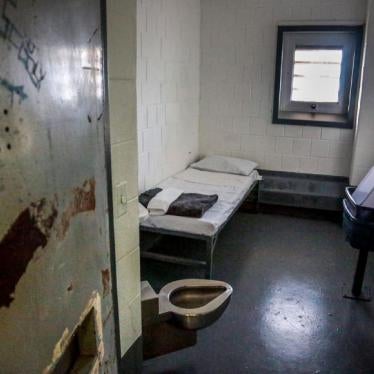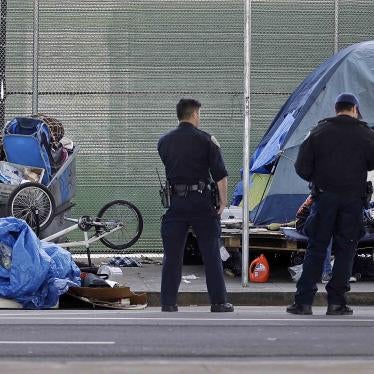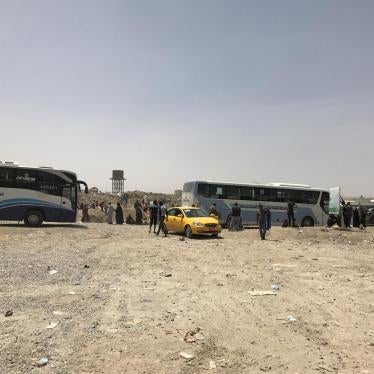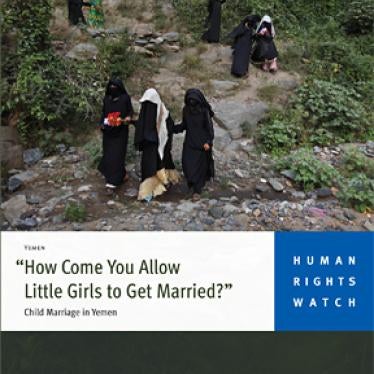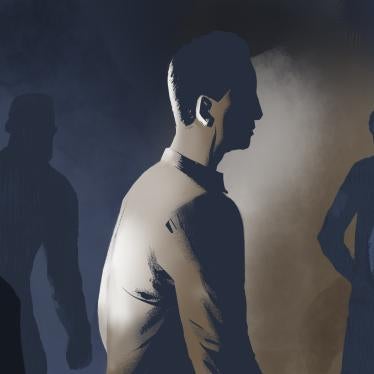Senator Portantino
Chair, Senate Appropriations Committee
California State Capitol, Room 412
Sacramento CA 95814
RE: Human Rights Watch Opposition to AB 645- as amended July 14, 2023
Dear Senator Portantino,
Human Rights Watch has carefully reviewed AB 645 and the amendments to AB 645 and must respectfully voice our opposition. AB 645 implements automated speed enforcement (ASE), establishing an unproven surveillance infrastructure [1] that will generate fines on a massive scale and almost certainly disproportionately impact Black, Indigenous, and people of Color (BIPOC) communities. These communities are already over-surveilled, over-policed, and historically disinvested from.
AB 654 expands surveillance without any corresponding commitments to decreasing traditional policing of traffic enforcement. This will create overlapping, racially disparate enforcement schemes that risk the misuse and misappropriation of surveillance equipment. Communities need investments in public transportation and traffic calming infrastructure – not cameras – to keep them safe.
I. ASE will continue and replicate racial bias.
Communities of color have experienced a long and painful history of government abuse of surveillance measures in the name of public safety. From the targeting of civil rights leaders under the 1960s-era federal surveillance program known as COINTELPRO, [2] to the widespread ariel surveillance of demonstrators during the Black-led protests in response to the murder of George Floyd, [3] communities of color endure privacy abuses that are deeply felt and illustrate the harms that unnecessary use of surveillance technology pose. [4]
California is by no means exempt from this history of abuse. The California Highway Patrol conducted widespread aerial surveillance of demonstrations following the murder of George Floyd, including zooming in to record footage of protesters’ faces, speakers at vigils, and even protesters dancing. [5] In Oakland, one of the pilot cities designated by AB 645, a 2015 report [6] showed that police used car-mounted license plate readers to disproportionately target low-income and BIPOC communities. A 2021 lawsuit additionally alleged that the police department stored the data associated with this targeting for years and gave the FBI unfettered access to the stored data. [7]
AB 645 posits that: “Speed safety systems can advance equity by improving reliability and fairness in traffic enforcement.” [8] However, the risk of racially disparate enforcement embedded in this bill is clear. The bill proposes that camera systems may be placed on a “safety corridor,” the designation of which will take into account collision data and numbers of traffic injuries and fatalities.” [9] But in Oakland, for example, the network of streets throughout the city where historically over 60 percent of annual severe and fatal crashes have occurred covers areas that census data indicates would have higher concentrations of BIPOC and low-income community members. [10]
As such, implementation of AB 645 risks the same results as those found in Chicago, where between 2015 and 2019, speed cameras ticketed households in majority Black and Latinx ZIP codes at two times the rate of majority white ZIP codes. [11] Similarly, in the District of Columbia, where photo enforcement accounts for 96 percent of citations and 97 percent of fines, drivers in Black-segregated areas were over seventeen times more likely to receive a moving violation than drivers in white-segregated areas. [12] This reflects a clear trend amongst automated enforcement mechanisms – they are routinely found to disproportionately target and ticket drivers in BIPOC neighborhoods.
AB 645’s recent vague amendment [13] requiring that placements be geographically diversified and across neighborhoods of varying income does not sufficiently address the racial justice implications at play. Nor does the broad requirement that prior to implementing a speed safety program the local governing body assess the potential impact “on civil liberties and civil rights,” [14] which does not specify the criteria for assessing the extent or nature of impact. The bill’s additional requirement for a “racial and economic equity analysis” would not be required until five years into the system’s implementation, [15] by which point a sizeable number of community members will almost certainly have been ticketed, subjected to fines and fees without a fair process for challenging them (see below), and experienced a curtailing of their freedom of movement for fear of surveillance.
II. ASE will entrench and expand surveillance.
History tells us that, despite assurances at the outset, expansions of policing technologies and systems of surveillance often shift from temporary to permanent and from limited to expansive. For instance, in 2015, the New York City Police Department launched a pilot neighborhood policing program in several of its precincts with the stated purpose of reducing violent crime and increasing police-community engagement through Neighborhood Coordination Officers (NCOs). Though initially a pilot program, the NYPD soon began expanding the program and by 2018, neighborhood policing expanded city-wide, signaling a transition from a temporary policing strategy to a long-term approach. Nor was its expansion and permanence a product of success. Though the program was meant to reduce violence, research indicates that it did not reduce crime rates, complaints against police, or racial disparities in low-level arrests. [16]
At the federal level, a temporary Congressional grant of authority for the Pentagon to direct unused military equipment to local police and sheriff’s departments became permanent and expanded less than ten years later. [17] This doubling down on militarization continues to this day, despite research finding weak or no causal connection between the transfer of weapons and other military equipment and decreased crime. [18]
Here, AB 645 already references the possible instillation of mobile radar or laser systems just two years after the fixed systems are implemented. [19] While AB 645 prohibits the use of facial recognition in conjunction with the system and places limits on how photos can be used, it does not explicitly prohibit the future addition of automated plate recognition on the same cameras. And despite citing the risks of bias embedded in the traditional enforcement mechanism of police traffic stops, [20] AB 645 makes no attempt to tie the implementation of ASE to a corresponding commitment to reduce traditional enforcement. This will result in overlapping, racially disparate enforcement schemes and expand the reach of law enforcement even further.
III. ASE creates due process concerns.
AB 645 gives jurisdictions the ability to mass produce violations and debt, while shortchanging due process protections. The photos gathered by these ASEs create a presumption of guilt of a civil violation [21] without any fair ability to challenge the claim. Alleged violators would have to pay fines prior to any hearing taking place and would only be eligible for a refund if, against enormous odds, they are able to prove during a skeletal proceeding that they did not commit the violation. [22]
The bill seems to envision that the only bases for challenging this presumption of guilt would be by a victim of car theft or by a rental or leasing company. [23] This does not account for the far more likely scenario of a family member or friend borrowing a car registered under a different person’s name. Within 30 days of the mailing of the notice of violation, the registered owner is required either to pay the fee, ranging from $50 to $500, [24] or to request review by the issuing agency. [25] The bill provides no guidance on what must be contained in this request for review. [26] The process then escalates with the onus remaining on the owner of the car, who may or may not have been the person actually driving. The person can then request an administrative hearing on the violation, but, absent a separate showing of proof of indigency, must nonetheless pay the penalty before the requested hearing even takes place. [27] If the person accused of a violation is under 18, the processing agency may nonetheless proceed against them. [28]
Despite the bill’s assurance that “the hearing shall provide an independent, objective, fair, and impartial review of contested automated speed violations” the only evidence the issuing agency is required to present is the notice of violation, registration information, and the ASE generated photo. [29] The agency is under no other requirements to show, for instance, the presence of proper signage, a correctly operating and duly inspected system, or any other facts relevant to the circumstances of the stated violation. [30] More troublingly, the municipal employee who issued notice of the violation is not required to take part in the administrative hearing, eliminating any opportunity for questioning by the examiner or cross-examination by the accused. [31] If somehow the accused is able to prove they did not commit the violation, it is only then they are refunded the civil penalty they previously paid. [32] This refund will not remedy the loss of earnings participants may experience from the time it takes to participate in the hearing. In the far more likely event that the accused loses the shell proceeding, they must pay an additional amount to file an appeal. [33]
AB 645’s assumption, that people have the resources or the time to navigate the burden that would be imposed by this system, ignores the reality facing low-income communities.
IV. ASE Takes up Resources that could be more effectively and equitably spent.
The system envisioned by this bill will not only financially burden community members, but localities as a whole. Between fiscal years 2014 to 2019 New York City’s speed camera program cost over $164 million, including an operating cost of $104 million. [34] Other cities also list annual ASE operating costs in the tens of millions. [35] The revenue generated from these programs has generally been found to cover the operating costs, but this nonetheless prioritizes an extractive scheme that monopolizes resources that could instead go directly to improving public transportation, sidewalks, and other more effective forms of infrastructure that promote both pedestrian and driver safety.
While the private third-party contractors localities will hire under AB 645 to install and run these systems may initially artificially deflate their quoted fees to obtain the contract, eventually they will seek to turn a profit, [36] and ongoing carrying costs like monitoring, upkeep, and updates of these systems will represent both necessary and potentially escalating costs. Keeping at bay the ever-growing threat of targeted hacking [37] of municipal technology will require pouring even more resources into the maintenance of these systems.
In contrast, the approach of traffic calming, [38] highlighted by AB 645 as only a piece of the broader enforcement strategy, presents a set of far more finite costs, that vary only depending on the types and volume of approaches deployed. [39] For instance, the city of Oakland estimates that, including staff, material, design and implementation, the cost of a speed bump is $7800, a median refuge $52,000, a stop sign $2500 per approach, a curb ramp $6500, and traffic circles between $78,000 and $130,00. [40] In contrast to the tens of millions many cities spend each year for ASE, the city of Berkeley has an annual budget of $50,000 for traffic calming projects, [41] San Bruno $100,000, [42] and Oakland $800,000. [43]
Traffic calming approaches also accomplish far more than speed enforcement. Among other benefits, they increase mobility for nondrivers, decrease car-based travel, reduce pollution and congestion on roads, and create more efficient physical spaces. [44]
Crucially, investments in traffic calming measures can also advance racial and economic equity, particularly in communities that have experienced redlining and historic disinvestment. Due in large part to a lack of investment in road design and infrastructure, pedestrians, bicyclists, and motorists in low-income neighborhoods are significantly more likely to experience injury from traffic. [45] Nationwide data for the five-year period 2015-2019 showed that Black, Indigenous and People of Color (BIPOC) were over-represented in pedestrian crashes considering their share of the population. Black community members represented 12% of the population during this time period but accounted for 21% of pedestrian fatalities. Latinx community members made up 19% of the population but 21% of pedestrian deaths. [46] And staggeringly, Indigenous Americans represented 0.7% of the population but accounted for 2.4% of deaths. [47] To address pedestrian safety issues, communities need investments in infrastructure and capital improvements – especially in those areas least equitably served by the city.
Rather than making traffic calming merely a piece of a broader strategy of surveillance and ticketing, it should stand alone as an effective, equitable, and structural solution. Pairing environmental design solutions with infrastructure improvements will both increase safety and encourage equitable investment in underserved communities of color. We urge you to implement those solutions rather than increasing surveillance through an automated ticketing infrastructure.
For these reasons, we must respectfully oppose AB 645.
Sincerely,
Olivia Ensign
Senior Advocate/Researcher
US Program
Human Rights Watch
[1] Justin Gallagher, “Red Light Cameras May Not Make Streets Safer,” Scientific American, August 16, 2018, www.scientificamerican.com/article/red-light-cameras-may-not-make-streets-safer/ (accessed July 5, 2023).
[2] Ed Gordon, “COINTELPRO and the History of Domestic Spying,” NPR, January 18, 2006, https://www.npr.org/templates/story/story.php?storyId=5161811 (accessed July 5, 2023).
[3] Zolan Kanno-Youngs, “U.S. Watched George Floyd Protests in 15 Cities Using Aerial Surveillance,” New York Times, June 19, 2020, https://www.nytimes.com/2020/06/19/us/politics/george-floyd-protests-surveillance.html (accessed July 5, 2023).
[4] United Nations Human Rights Council, “Racial Discrimination and Emerging Digital Technologies: A Human Rights Analysis,” A/HRC/44/57, July 2020, https://daccess-ods.un.org/access.nsf/Get?OpenAgent&DS=A/HRC/44/57&Lang=E (accessed July 7, 2023).
[5] “ACLU Investigation Uncovers Footage from Widespread Aerial Surveillance of Racial Justice Protests,” ACLU, news release, November 16, 2021, https://www.aclunc.org/news/aclu-investigation-uncovers-footage-widespread-aerial-surveillance-racial-justice-protests (accessed July 7, 2023).
[6] Dave Mass and Jeremy Gillula, “What You Can Learn from Oakland’s Raw ALPR Data,” EFF, January 21, 2015, https://www.eff.org/deeplinks/2015/01/what-we-learned-oakland-raw-alpr-data (accessed July 7, 2023)
[7] Annie Sciacca, “Oakland Police Gave FBI “Unfettered Access” to License Plate Reader Data, According to Lawsuit,” East Bay Times, September 4, 2021, https://www.eastbaytimes.com/2021/09/04/oakland-police-give-fbi-unfettered-access-to-license-plate-reader-data-according-to-lawsuit/ (accessed July 7, 2023)
[8] California AB 645, “Vehicles: Speed Safety System Pilot Program (Friedman, Santiago, and Ting),” 2023, https://leginfo.legislature.ca.gov/faces/billNavClient.xhtml?bill_id=202320240AB645 (accessed July 5, 2023).; AB 645, Sec. 1(k).
[9] AB 645, Sec. 4, Art. 3 (b)(1)(a).; California Vehicle Code, “§ 22358.7,” 2022, https://leginfo.legislature.ca.gov/faces/codes_displaySection.xhtml?lawCode=VEH§ionNum=22358.7. (accessed July 5, 2023).
[10] Alejo Alvarado, “The Racial Equity Implications of Road Safety Enforcement in Oakland, CA,” Department of City and Regional Planning, University of California, Berkeley, April 13, 2021, https://safetrec.berkeley.edu/sites/default/files/alejoalvarado_safetrec_final.pdf (accessed July 5, 2023), p. 9,12. (“If ASE were to be implemented within the city of Oakland, they would primarily target these areas. Because of settlement patterns, lower income people of color would be primarily affected, as they live closer to the potential areas of implementation.”)
[11] Emily Hopkins and Melissa Sanchez, “Chicago’s Race Neutral Traffic Cameras Ticket Black and Latino Drivers the Most,” ProPublica, January 11, 2022, https://www.propublica.org/article/chicagos-race-neutral-traffic-cameras-ticket-black-and-latino-drivers-the-most (accessed July 5, 2023).
[12] William Farrell, “Predominately Black Neighborhoods in D.C. Bear the Brunt of Automated Traffic Enforcement,” D.C. Policy Center, June 28, 2018, https://www.dcpolicycenter.org/publications/predominately-black-neighborhoods-in-d-c-bear-the-brunt-of-automated-traffic-enforcement/ (accessed July 5, 2023).
[13] AB 645, Sec. 4, Art. 3 (b)(3).
[14] AB 645, Sec. 4, Art. 3 (h)(1).
[15] AB 645, Sec. 4, 22430.
[16] Brandon Beck, Joseph Antonelli, and Gabriela Piñeros, “Effects of New York City’s Neighborhood Policing Policy,” Police Quarterly 25(4) (2022): 470–496, accessed July 5, 2023, doi: 10.1177/10986111211046991.
[17] “Federal Militarization of Law Enforcement Must End,” ACLU, news release, May 12, 2021, www.aclu.org/news/criminal-law-reform/federal-militarization-of-law-enforcement-must-end (accessed July 5, 2023).
[18] Anna Gunderson et al., “Counterevidence of Crime-reduction Effects from Federal Grants of Military Equipment to Local Police,” Nature Human Behaviour 5 (2021): 194-204, accessed July 5, 2023, doi: 10.1038/s41562-020-00995-5.; Kenneth Lowande, “Police Demilitarization and Violent Crime,” Nature Human Behaviour 5 (2021): 205-211, accessed July 5, 2023, doi: 10.1038/s41562-020-00986-6.
[19] AB 645, Sec. 22426 (f).
[20] AB 645, Sec. 1(d).
[21] AB 645, Sec. 22426 (e).
[22] AB 645, Sec. 22427 (b)(2); (c)(8).
[23] AB 645, Sec. 22426 (e)(6)
[24] AB 645, Sec. 22426 (c).
[25] AB 645, Sec. 22426 (e)(4); Sec. 22427 (a).
[26] AB 645, Sec. 22427 (a).
[27] AB 645, Sec. 22427 (b)(2).
[28] AB 645, Sec. 22427 (c)(2).
[29] AB 645, Sec. 22427 (c)(5).
[30] Ibid.
[31] Ibid.
[32] AB 645, Sec. 22427 (c)(8).
[33] AB 645, Sec. 22428.
[34] Hella Alnajjar, “New York City’s Speed Camera Program Costs Over $164 Million Including an Operating Cost of $104 Million During Fiscal Year 2014 to 2019,” New York City DOT, July 1, 2020, https://www.itskrs.its.dot.gov/node/209537 (accessed July 5, 2023) p. 15.
[35] Office of the Controller – City Services Auditor Division, “Automated Speed Enforcement Implementation: Survey Findings and Lessons Learned from Around the Country,” November 12, 2015, https://sfcontroller.org/sites/default/files/FileCenter/Documents/6928-Automated%20Speed%20Enforcement%20Implementation%20-%20Survey%20Findings%20and%20Lessons%20Learned%20From%20Around%20the%20Country.pdf (accessed July 5, 2023).
[36] See Derek Thompson, “Why City Life Has Gotten Way More Expensive,” The Atlantic, June 13, 2022, https://www.theatlantic.com/newsletters/archive/2022/06/uber-ride-share-prices-high-inflation/661250/ (accessed July 5, 2023).
[37] Shelly Brisbin, “Ransomware Attacks, Like the One Targeting City of Dallas, Are Becoming More Common,” Texas Standard, June 19, 2023, https://www.texasstandard.org/stories/hackers-target-dallas-tx-computer-system-hold-data-ransom/#:~:text=Hackers%20targeted%20the%20City%20of%20Dallas%E2%80%99%20computer%20systems,complaint%20system%2C%20municipal%20courts%20and%20water%20bill%20payments (accessed July 5, 2023).
[38] The US DOT Federal Highway Administration definition of traffic calming is as follows: “The primary purpose of traffic calming is to support the livability and vitality of residential and commercial areas through improvements in non-motorist safety, mobility, and comfort. These objectives are typically achieved by reducing vehicle speeds or volumes on a single street or a street network. Traffic calming measures consist of horizontal, vertical, lane narrowing, roadside, and other features that use self-enforcing physical or psycho-perception means to produce desired effects.”
[39] Todd Litman, “Traffic Calming: Benefits, Costs and Equity Impacts,” Victoria Transport Policy Institute, December 7, 1999, www.vtpi.org/calming.pdf (accessed July 5, 2023).
[40] City of Oakland, “City Council's April 2021 Traffic Safety $800k Allocation for High Priority Traffic Calming and Speed Bumps: OakDOT Prioritization and Process,” https://www.oaklandca.gov/projects/traffic-safety-800k-allocation-oakdot-prioritization-and-process (accessed July 5, 2023).
[41] City of Berkeley, “Request Traffic Calming,” 2023, https://berkeleyca.gov/city-services/livable-neighborhoods/request-traffic-calming (accessed July 5, 2023).
[42] City of San Bruno, “City of San Bruno Traffic Calming Program,” December 2020, https://www.sanbruno.ca.gov/DocumentCenter/View/733/Traffic-Calming-Program-Brochure-PDF (accessed July 5, 2023).
[43] City of Oakland, “City Council's April 2021 Traffic Safety $800k Allocation for High Priority Traffic Calming and Speed Bumps: OakDOT Prioritization and Process,” https://www.oaklandca.gov/projects/traffic-safety-800k-allocation-oakdot-prioritization-and-process (accessed July 5, 2023).
[44] See FHWA Course on Bicycle and Pedestrian Transportation, “Lesson 11: Traffic Calming,” FHWA, https://safety.fhwa.dot.gov/ped_bike/univcourse/pdf/swless11.pdf (accessed July 5, 2023).
[45] Sarah Fecht, “Accident-Zone: Poorer Neighborhoods Have Less-Safe Road Designs,” Scientific American, May 3, 2012, https://www.scientificamerican.com/article/accident-zone-poorer-neighborhoods/ (accessed July 5, 2023).
[46] Governors Highway Safety Association, “Pedestrian Traffic Fatalities by State: 2021 Preliminary Data (January - December),” May 2022, https://www.ghsa.org/sites/default/files/2022-05/Pedestrian%20Traffic%20Fatalities%20by%20State%20-%202021%20Preliminary%20Data%20%28January-December%29.pdf (accessed July 5, 2023).
[47] Ibid.
